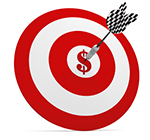10/6/2016
An estimated 15.4 million Americans were victims of identity fraud in 2016, an increase of 16% over 2015. Identity thieves racked up $16 billion in fraud-related losses and U.S. data breaches tracked in 2016 reached an all-time high of 1,093.
With identity theft continuing to make gains year over year, consumers and businesses alike should be on their guard to protect against this threat. Keeping identity thieves at bay begins with establishing a solid line of defense when it comes to your personal information.
Safeguard Physical Documents
The first step in shielding yourself from identity theft is getting your financial documents under lock and key. If an identity thief is able to gain access to your Social Security card, birth certificate, or bank account or credit card statements, they have virtually everything they need to wreak havoc with your financial life.
Investing in a home safe is one option. Renting a safe deposit box is another. Regardless of what method you choose, the goal is to make sure that you're keeping your most important financial details away from prying eyes. If you want to cut down on the paper trail altogether, consider making the switch to electronic statements on all your accounts.
Manage Your Online Information Securely
The internet has made it easier to do just about everything these days, from paying bills to shopping, but it's also created a host of opportunities for identity thieves to swoop in and steal your information. Phishing scams are a prime example.
Using seemingly legitimate-looking emails, identity thieves are able to trick consumers into handing over personal details. In some instances, phishing emails may contain links or attachments that download malware onto your computer when clicked, allowing an identity thief to track your movements online. If you're checking your bank or credit card accounts, you may be unknowingly handing over your login information.
Using caution when you receive emails from unknown sources can go a long way toward heading off identity theft. Don't click on links or attachments within emails if you don't recognize the sender, and verify any communications from your bank first before replying. Be sure to use unique passwords for all of your online logins and update them periodically. Finally, check to see that your computer's firewall is turned on when you're surfing the net.
Be Smart About Mobile Banking
If you prefer to do your banking on the go, you're not alone. According to the Federal Reserve, 53% of smartphone owners use mobile banking and that number is expected to hit 81% by 2020. While mobile banking can make things like checking your balances or transferring funds a breeze, you have to be careful about how you're accessing it.
Using unsecured public Wi-Fi to log in to your bank's mobile banking app, for example, is a big no-no. When you're transmitting your financial details across an unsecured network, it doesn't take much for an identity thief to intercept them. The takeaway? Stick to secured network connections when you're doing your financial business.
Before you visit a website on your mobile device, check the security certificate. If the page address doesn't begin with "https", you may want to steer clear. Also, bookmark sites you frequently visit to ensure you are going to the correct sites instead of imposter sites. Otherwise, you could be opening yourself — and your information — up to identity thieves. If you visit a secure page that requires you to log in, make sure you've completely logged out before navigating away.
Monitor Your Bank and Credit Accounts
In many cases, identity theft isn't discovered until well after the fact. For instance, you may not realize someone has opened a credit card account in your name until you begin receiving phone calls from a debt collection agency.
Maintaining a close eye on your bank and credit card accounts may help you to root out identity theft faster. Check your monthly statements closely for purchases or other charges you don't recall making. Consider setting up email and text alerts to notify you when a new purchase is made or when your balance reaches a certain limit.
Finally, it's a good idea to check your credit report on a regular basis to make sure there are no new accounts or inquiries for credit you don't recognize.
By federal law, you are entitled to receive a free copy of your credit report, once every 12 months, from each of the three credit reporting agencies (Equifax, Experian, and TransUnion) via AnnualCreditReport.com. You can stagger these requests across the year — rather than checking them all at once — to give you better coverage. It's also a good idea for married couples to check the reports for both spouses.
